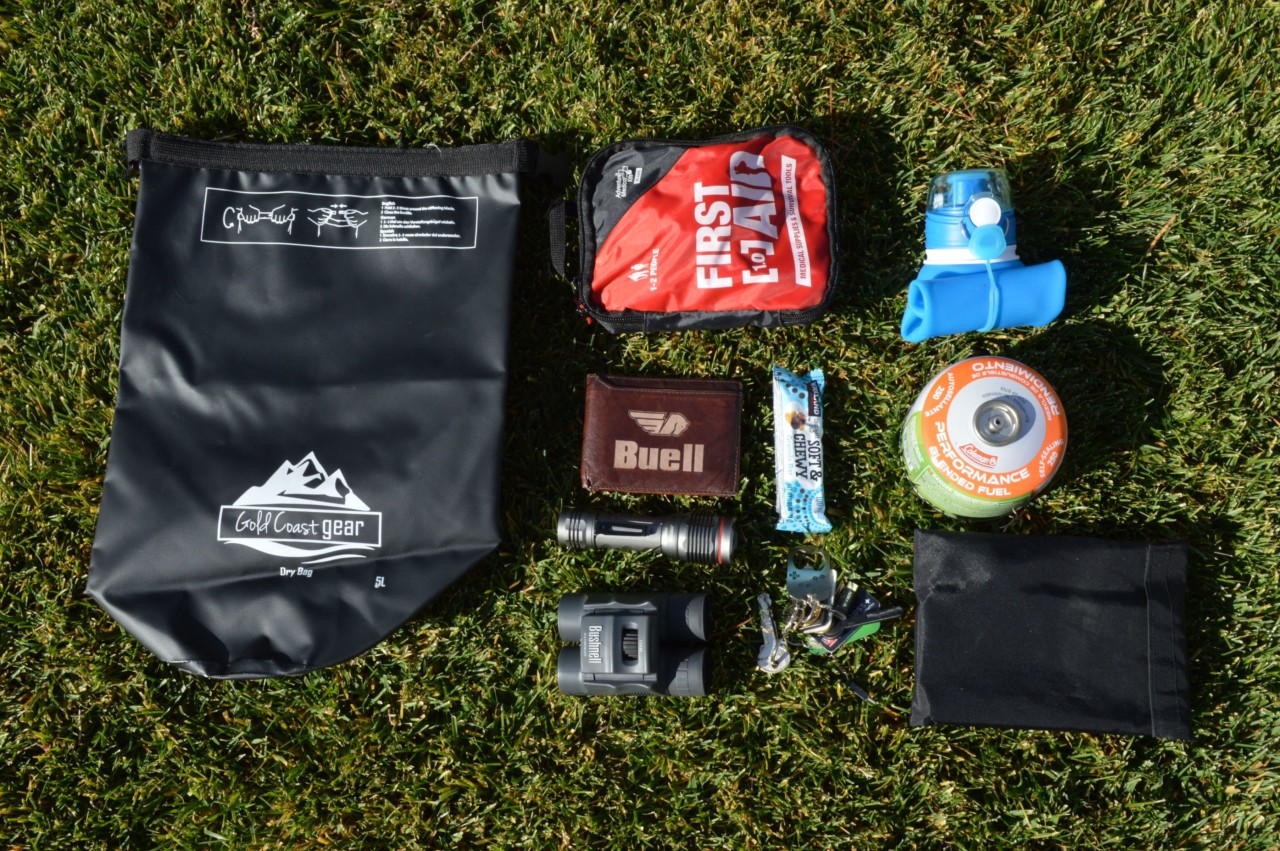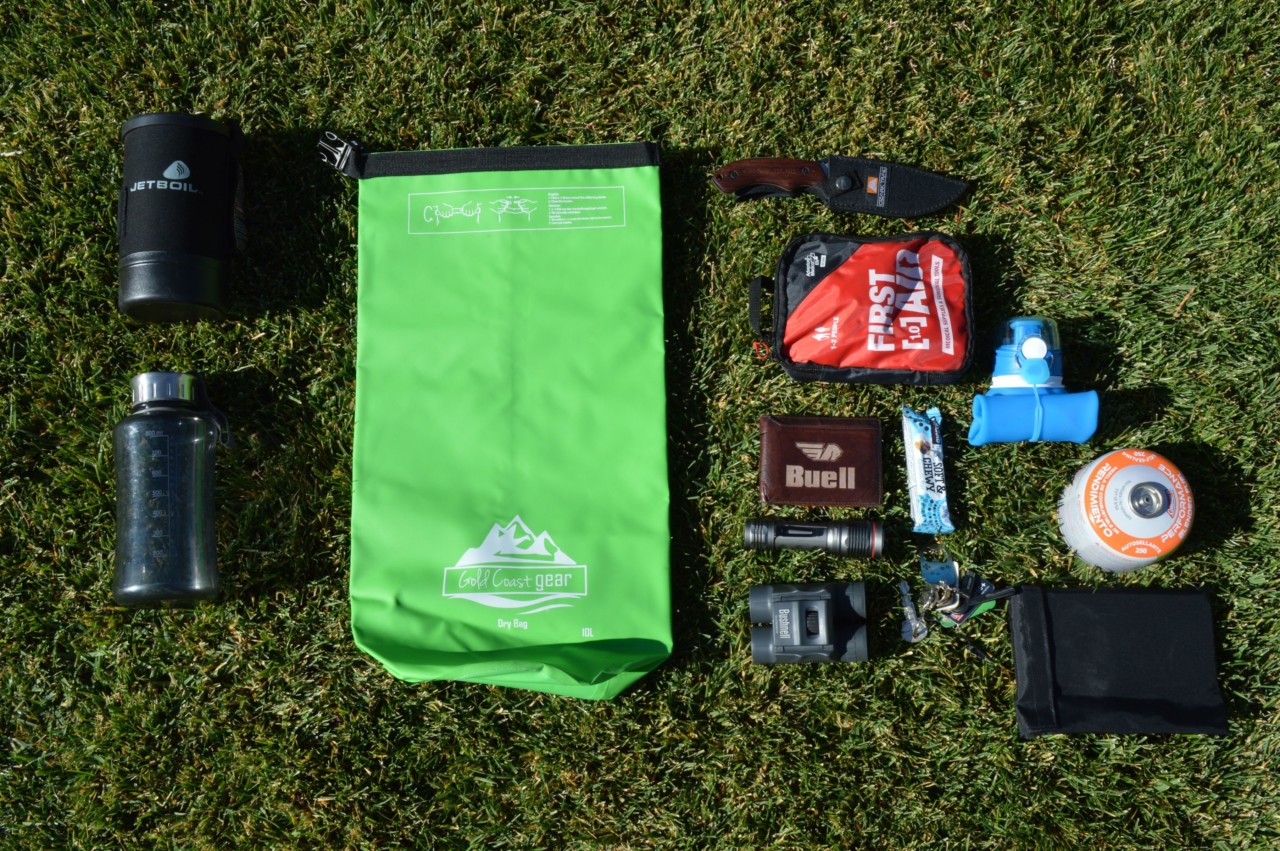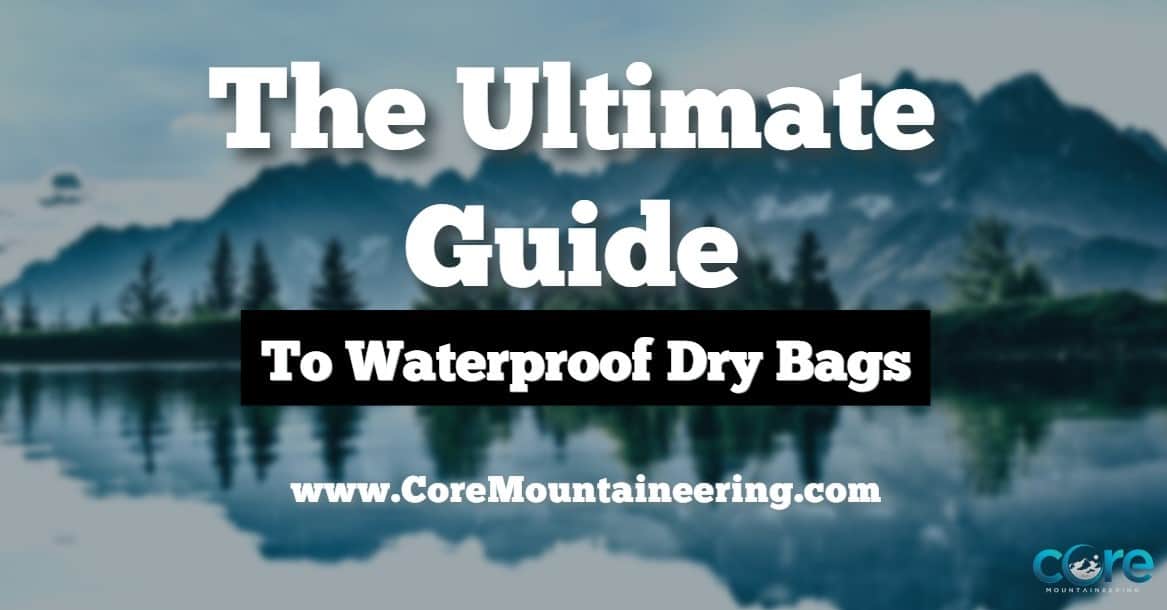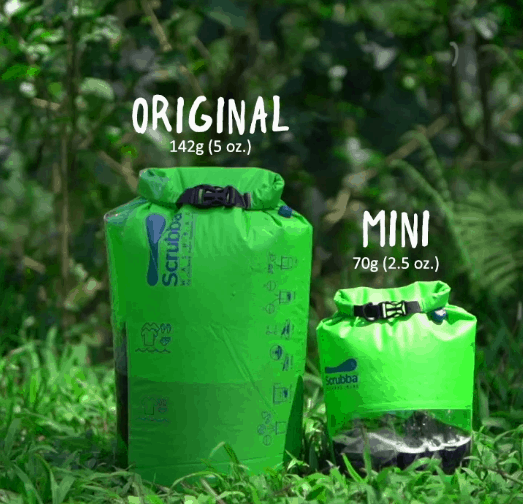Dry bags are a must-have piece of gear for any outdoor adventurer. While they are simple, easy to use, you’ll find there are many different styles, sizes, materials, and features that go into them. I hope to guide you through the decision-making process with this ultimate guide to waterproof dry bags. Let’s get started!
If you’re just looking for our best dry bag recommendation, check out Gold Coast gear for all sizes and colors.
What’s a Waterproof Dry Bag?
As the name implies, their primary job is to keep any piece of outdoor gear dry. The bag is a flexible container, typically with a roll-top closure. Roll-top Dry Bags provide a Watertight enclosure by the way they are secured. Instead of a Zip-top or zipper type of closing mechanism, the bag is secured by rolling down or dog-earing the top at least three times, them clipping the buckles together.
We will go over other ways of securing a dry bag, but the most reliable ones are closed with a roll-top seal. The reason Mountaineers prefer this over a zipper and zip-top closing style is that a rolling top is virtually indestructible.
Two pieces of fabric being pressed together won’t wear out like a waterproof zipper. It will perform the same in a cold environment (unlike a zipper) and can easily be closed with gloves on.
Who Uses Dry Bags & What Are They For
Waterproof dry bags are one of the most common items for many outdoor activities. It’s easy to see why, over the years, many people have adopted them.
- Backpackers: Wanting to separate valuable gear keeping it clean and dry. Have multiple smaller dry bags of different colors help keep them organized.
- Water Sports: It’s ubiquitous to find a large waterproof dry bag on a Kayak or Canoe. Waterproof backpacks are used for paddleboarding or SUP for short. Large dry bags are also routinely used for rafting as well.
- Camping: Dry bags are used to keep wet gear separate from dry clothes. Small dry bags can hold electronics, keeping them safe from water and dust.
- Alternative Uses: Using them as a pillow, gathering water, a bear bag, and a boat anchor.
These are just some of the uses for people that need to protect their equipment.
Different Closing Dry Bag Styles
Closing roll-top dry bags is recommended, but let’s look at other ways of closing them. Let’s compare the zip-top and zipper closing bags to the roll-top.
Zip-Top or Ziploc Closing Dry Bag
This type of bag is excellent for smaller, lighter items that fit nicely in the small pockets of a backpack. I keep a few Ziploc bags whenever I go hiking to keep my toiletries clean. The problem with this closing mechanism is when you have larger, more substantial items.
With heavier gear rolling around in a Ziploc bag, the top can easily blow out. If you close a Ziploc bag with air in it, a small amount of pressure will pop the bag right open. A roll-top dry bag won’t do this. If enough force is applied to a roll-top style bag, the seams will blow out before the top will.
Cold weather will make the zip-top stiff and hard to close. While they will be fine in most temperatures the cold weather will affect the performance.
Freegrace sells a dry bag that has a zip-top combined with a roll-top. While this isn’t necessary or really adds any extra protection, they claim it’s for added security. They also note that in cold weather, the zip-top won’t perform well, and oil needs to be applied before closing the bag.

Waterproof Zipper Dry Bags
A true waterproof zipper will not leak, but the problem is many so-called “Waterproof Zippers” are merely water-resistant. This kind of zipper will let water leak in if they are exposed in the rain or dropped in water long enough. Manufacturers do this to save on costs because true waterproof zippers are expensive.
Another downside is that waterproof zippers are stiff, so they don’t slide easily like the normal zippers we’re used to using. This can be a real pain in cold weather as the zippers will be even stiffer. Lubricating the zipper can help with this stiffness.
As with zip-top bags, zippers can blow out when overstuffed. If this happens while you’re out on the trail, you could be stuck with a useless bag for days.
The last downside is that zipper bags are difficult to close with gloves on. In cold weather, the zipper will stiffen up, making it even hard to close with thick winter gloves.
How to Choose The Best Dry Bag
Before we look at different sizes of dry bags, we need to choose a material first. Dry bags generally come in two different categories, thick heavyweight or thin ultra-lightweight material.
Thick Dry Bags
Some dry bags are heavy, but they’re built to take a beating. Take a look at a dry bag made from 500D PCV Tarpaulin for durability. It’s tough, but at the downside of being very heavy and inflexible. These kinds of dry bags are usually recommended as “best value” because they last for years in harsh conditions.

With a thicker, stronger dry bag, you’ll have more options and flexibility as well. You’ll have the utility to use them as intended and all the alternative ways that are not recommended with thin dry bags. Using a dry bag as a bear food bag for an example.
Trying to pitch the bag high enough on a tree with a stick can poke holes if the bag is too thin. Or using a dry bag with rocks inside as a kayak anchor.
Ultralight Dry Bags
Lightweight dry bags are on the other end. They are thin, flexible, and lightweight but at the cost of durability and are on the upper end of the price. When hiking, every ounce counts, so a nylon dry bag is a good fit.
They are also more flexible, so storing an empty nylon dry bag can fit in more places. If they come with a shoulder strap, they are excellent for day hiking too.
If you are concerned about getting your pack weight down as much as possible, go with an ultralight dry bag. Be aware that you are giving up some versatility with a thin bag.
Best Dry Bag Material
This is a whole subject in itself, but most dry bags are going to be made of nylon or Polyester PVC Tarpaulin. Both of these fabrics are synthetic. Polyester, while not as strong as nylon, does have some advantages in UV performance. Nylon is pound for pound tougher than polyester.
A spec you can look at for dry bag fabric is Denier. The (D) at the end of the number is referring to Denier. Denier is a metric used to describe the thickness or density of the material. The higher the Denier, the stronger the fabric, but only if we’re talking about the same type of fabric. For example, 450D nylon is much stronger than 600D polyester.
This does not translate directly across all fabrics. Generally, for dry bag fabric, it’s a metric for understanding the durability of the bag. Each fabric is also inherently different in strength.
The reason you’ll see Polyester PVC Tarpaulin recommended as the “Stronger” dry bag is due to thickness. Take the dry bag pictured below, 500D PVC Tarpaulin is much thicker than a 15 Denier siliconized nylon used by Sea to Summit ultralight dry bags. All while being about half the price as well.

Nylon Dry Bags
Nylon is a whole family of synthetic fabrics. It’s a polymer that can be formed into various shapes and fibers through melt-processing. For the most part, it’s plastic. While nylon has much better waterproof traits than a common fabric like cotton, it tends to tear when punctured. However, this can be resolved by implementing various weaves and sewing patterns, such as ripstop nylon fabric.
Rip-Stop Nylon Dry Bags
Ripstop nylon dry bags are commonplace now, particularly in the mid-range on price and weight. Rip-stop nylon integrates a grid of thicker threads sewn directly into the nylon at close intervals. This prevents the issue of ripping or unraveling if the nylon is punctured and also helps to waterproof the material.
On the other hand, because rip-stop is used in light fabrics (nylon), abrasion or heavy use can cause holes to open along the seams faster than in other thicker fabrics (PVC Tarpaulin). As lighter threads and the thicker ripstop threads wear at different rates. Ripstop is used in sails, parachutes, and hot air balloons and was originally developed in WW2 to replace silk parachutes.
Nylon is in the middle road as far as weight. It’s not feather-light like the Sea to Summit Ultra-Sil Nano Dry Sacks, and they reflect this on price as well. When looking for a rip-stop nylon dry bag, you’ll notice the small squares throughout the bag material.

Cordura Dry Bags
I see the Cordura name thrown around in the backpacking industry. Cordura is not a fabric; it’s a brand name associated with high-quality materials and fabrics you’ll see on all types of camping gear.
Some dry bag brands use the Cordura name as the fabric used. This indicates that the dry bag is made of Cordura nylon or Cordura fabrics, saying that they used a premium brand-name fabric.
Dry Bag Sizes and How Much Will Fit in Each Sack
What’s the correct size of the dry bag? You’ll probably end up with a few different sizes and options. This section of this guide is made to show you how much gear you can stuff into each of the commonly sized dry bags.
There are few oddball sizes from different manufacturers, but generally, 2 liters up to 30 liters dry bags are what you’ll find. I like to have the option to use a shoulder strap with every size, so the larger bags are still manageable. When we get into larger sizes above 30 liters, they should include padded shoulder straps and be a dedicated backpack.
All of the dry bags pictured here are thick, 500D Tarpaulin PVC 0.50mm bags. Note that all the weights I include are for these strong dry bags, but as mentioned above, they also make ultralight dry bags that are much lighter, sacrificing durability.
The reason I chose this material is so I can use them in many ways not intended in the traditional sense. They’re thick, will last for years, take a ton of abuse, and stay waterproof.
Every size dry bag also included a shoulder strap to easily carry. They are great for using as a day bag after you set up camp, and you just want to do some light hiking around. I use a 5-liter dry bag most of the time as a fishing bag to keep bait and tackle in. Depending on the amount of tackle you have any size will work well for this.

2-liter Dry Bag
This is the smallest size dry bag I would buy. Sea to summit sales a 1 liter, but at that size, you might as well stick to a Ziploc bag and save your money. This size is great for small items like wallets, keys, and your cell phone. They’re easy to keep clipped on your hiking backpack for quick access when you need to take a quick picture.
Having a few different small bags inside your backpack helps separate smaller items for quick access. I like to use different color bags for this, so I’m not checking every small bag for the item I need at that time.


5-liter Dry Bag
This size is a sweet spot for most people. We’ve been selling dry bags for a few years now, and this is by far the most popular size (in black if you’re curious). It’s still small enough to strap on your backpack, as well as to roll up 2 inside your pack. With this size, you can easily keep a camping stove or bring along your larger camera like a DSLR.
If you’re not sure about what size you’re going to need when first picking out a dry bag, I recommend 5 liters. Even if it turns out that the size is too small and you need a bigger bag, it will still be easy to utilize the 5-liter bag.

10-liter Dry Bag
Big but not too big. Stuff your overnight clothes as well as your larger camera in here. I always roll up a light windbreaker to wear after I set up camp, so it must stay dry. With 10-liters, there will be plenty of room for some backpacking luxuries.
At this size, it makes a nice hiking day bag to go with you when you’re exploring, and you don’t want to carry your heavy hiking backpack. With 2 and 5 liters, a shoulder strap isn’t essential, but a large 10 liters dry bag it’s a must-have.

20-liter Dry Bag
At this size, remember that you can roll down a larger dry bag to any size you want while having the option for larger capacity. If you’re unsure if a 20 liter will be too large, just remember it’s an option to roll down further than the recommended three times.
I would definitely want a strap at 10 or 20 liters for day hiking. Having a shoulder strap included with your dry bag is also nice to hang on a tree while you camp, to pull gear out as you need it.

30-liter Dry Bag
This is the size of a small school backpack. You can see all the gear that fits inside, and a sleeping bag can also be comfortably stuffed inside a 30-liter dry bag as well. Sleeping in a wet bag all night sounds like a horrible way to freeze, so ensuring it stays dry no matter what is a must.
A 30-liter dry bag that doesn’t have shoulder straps it’s kind of a bare-bones option. With only one shoulder strap, the bag will start to feel heavy while day hiking.
If a 30-liter bag seems too large, look into two or three separate 10-liter bags. Or, mix it with a few smaller bags of different colors. This is a good option if you have a lot of gear and want to stay organized.

30-liter and Larger Dry Bag Backpack
A dry bag backpack is a great option for kayaking or other water sports. These large bags will keep your gear dry and in one place. With no internal frame, a heavy backpack can feel weighed down with little weight on the hips.
This particular one does have a hip and sternum strap; only the shoulder straps and back have padding. From the picture, you can see everything I put inside this backpack. Theirs also plenty of features on the outside for fishing poles and water bottles. These waterproof backpacks also come with a 2-liter dry bag of matching color.

Features On Dry Bags
Zippers, handles, clear plastic windows, or a little valve to let the air out. Is it added bulk and cost, or are these nice creature comforts? It’s going to come down to your needs. Out in the woods or on the lake, the fewer things to go wrong, the better. When closing a dry bag, the top forms a natural handle, so every dry bag has a handle anyways.
A valve to let the air out is also not necessary if closed the way we covered down below. Although, if you’re using a large dry bag backpack, a valve can help remove most of the air. A window is nice, but it creates another area to let leak water in. It’s up to you!

A mesh pocket on the side of a larger bag will be good for holding a water bottle. Added pockets with waterproof zippers are nice for holding items like keys or lip balm.
I’ve already mentioned that I like a shoulder strap on all dry bags. These will include a D ring to remove the strap if not needed. If you know that you’ll never use a strap and want to get as light as possible, you can cut the D ring off to save an ounce.
Uses and Alternative Uses of Dry Bags
I wrote an article about all the alternative uses, but I’ll cover some of the more common ways here. I’ll keep these posts up to date when I find new ways or someone leaves a comment.
Washing Your Camping Clothes in a Dry Bag
Theirs dedicated dry bags for washing your camping gear if you’ll be doing it often. Scrubba and Laundrez are two popular dry bag portable laundry systems. They are a lot like a dry bag, except they have a flexible washboard and gripping surface on the inside.
Separating Dirty Clothes
An Air Pillow Dry Bag
Transporting Water
Dry bags are already waterproof, so they make a nice scoop and bucket for bringing water to camp. Don’t use water purifying tablets in them, put the water in a different container for that. Collapsible water containers are made for this and should last a few years.
I’d also recommend NOT using a dry bag for water storage. Platypus, CamelBak, Nalgene, and others offer inexpensive water bladders made for storing water.
An Anchor for a Kayak
Who likes to carry a three-pound anchor when kayaking? They do sell dedicated kayaking bag anchors on Amazon, check prices here. These bags look a lot like dry bags, and we already have them, with us. so let’s make another use of them.

Fill the dry bag with some smooth rocks or sand, tie some rope, and use a carabiner, and we have ourselves an anchor. The dry bag used should be a thick bag as the reviews for these show sometimes they rip, no ultralight dry bags for this.
If you’d like to see all the alternatives for dry bags, check our article here.
How to Properly Close a Roll-Top Waterproof Dry Bag
The most important thing is to remember that you need to fold at least three times.
- Fill your dry bag up to 3/4 full.
- Remove the excess air and pinch the top blades together.
- Dog ear and fold at least three times down for a watertight seal.
The last thing to do is clip the buckles together, and you’re good to go!
How to Test If a Dry Bag Will Leak
I’ve tested many dry bags over the years. I test dry bag backpacks the same way as the smaller ones.
- Fill the dry bag halfway with water.
- Instead of pushing the air out as you would typically, keep the air inside.
- Start rolling down the top, applying pressure inside the bag.
- Hold the pressure for a minute and see if water leaks out the seams.
When properly closed it’s unlikely a dry bag will leak from the top. This is one of the reasons roll-top dry bags have been so popular over the years. If your bag does have a very small leak out the seams it can still be used, it’s up to you. This test is to see “how much” water could possibly leak into the bag.
Care and Maintenance
For the most part, people use dry bags because they are care and maintenance-free. If you choose to get a dry bag without the zip-top and no zippers, nothing needs to be done with them. Some good practices to care for them are:
- Avoid setting them on sharp rocks. Be aware if they are on the outside of your backpack or using them as a day bag not to brush up against rocks or spiky bushes.
- When the bag gets dirty, clean it with water and a little bit of soap. Raise thoroughly to remove all the soap residue off. Avoid washing a dry bag in a washing machine because excess agitation can damage the container.
- Dry bags are made of synthetic material, avoid fire and extreme heat.
- Keep away from solvents, if your bag comes in contact with insect repellent such as DEET, clean the bag immediately.
Recommended Best Dry Bags
Check out our recommended gear section; we have spent hundreds of hours researching and testing the best camping and hiking gear on the market. These items are battle-tested and can be recommended without any equivocation.
If you’re looking for thin and lightweight dry bags, you can’t go wrong with Sea to Summit. These are lightweight nylon bags with few features. While they are not made to be set on sharp rocks or bushes, they will keep your gear safe and dry. See the current price of the Sea to Summit Ultra-SIL Dry Sack on Amazon here.

For sturdy, durable dry bags that are built like a tank, check out Gold Coast gear dry bags. They are in the heaver category, but they will last forever. They come with a Full Lifetime Warranty, even for normal wear and tear. They come in all sizes and a wide range of colors. See the current price of Gold Coast gear dry bags on Amazon here.

I hope this guide has been helpful in choosing a dry bag for the first time or adding to your camping gear. If you have any ideas for dry bags or the best dry bag to use, please leave a comment down below.
FAQ – Waterproof Dry Bags Guide
Are Dry Bags Submersible?
“The simple answer is, they can be to a certain depth. While they aren’t made to be taken deep into the water, any high-quality dry bag should be able to take a quick dip in the water.
Are Dry Bags Really Waterproof?
The reason why dry bags are very popular in the market is that they are waterproof.
Dry Bags Float?
Yes, even if there is not much air in a dry bag they will most likely have enough buoyancy.
What Size Dry Bag Do I Need?
Check our illustrated guide above to see everything that fits in.










